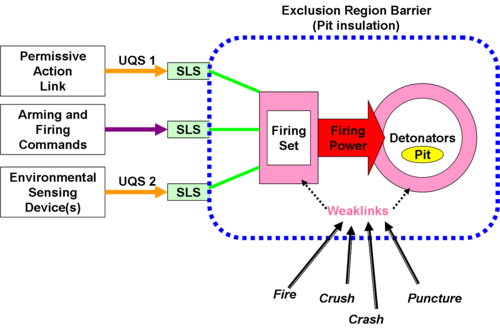Weak link-strong link: Difference between revisions
imported>Howard C. Berkowitz No edit summary |
imported>Howard C. Berkowitz No edit summary |
||
| Line 6: | Line 6: | ||
*'''Environmental''' signals from [[Environmental Sensing Device (military)|Environmental Sensing Devices]]s, especially of a predicted weapon trajectory, but also of such weapon delivery signatures such as increasing barometric pressure and radar altitude for a bomb | *'''Environmental''' signals from [[Environmental Sensing Device (military)|Environmental Sensing Devices]]s, especially of a predicted weapon trajectory, but also of such weapon delivery signatures such as increasing barometric pressure and radar altitude for a bomb | ||
The exclusion system barrier also provides thermal protection to give a [[fire-resistant pit]], and a tamper-resistant shield. | The exclusion system barrier also provides thermal protection to give a [[fire-resistant pit]], and a tamper-resistant shield. | ||
These unique and operational signals arm the '''strong link''' switches within the [[weak link-strong link]] safeguard of the '''firing set''', which are probably part of the high voltage system that charges the capacitors that power the multiple [[detonator]]s. If any predesignated weak link condition comes into being, such as crushing or puncture of the exclusion barrier, fire surrounding it, or a crash if the weapon is fuzed for airburst, the weak link opens and breaks the firing circuits. For certain conditions, such as crashes, a more complex weak link sensor may initiate a self-destruct for the weapon, one which will not produce a nuclear yield. | These unique and operational signals arm the '''strong link''' switches within the [[weak link-strong link]] safeguard of the '''firing set''', which are probably part of the high voltage system that charges the capacitors that power the multiple [[detonator]]s. If any predesignated weak link condition comes into being, such as crushing or puncture of the exclusion barrier, fire surrounding it, or a crash if the weapon is fuzed for airburst, the weak link opens and breaks the firing circuits. For certain conditions, such as crashes, a more complex weak link sensor may initiate a self-destruct for the weapon, one which will not produce a nuclear yield. | ||
Revision as of 17:56, 3 May 2010
Weak link-strong link is Weapons themselves have a growing number of internal and colocated safeguards against accident and misuse. The graphic shows a schematic of a weapon, which is surrounded by a mechanically and electrically robust exclusion region, into which flow several unique signals (UQS) recognized by designated Strong Links, probably through a cryptographic mechanism.
- Intention signal from a Permissive Action Link, which must come from higher authority than the crew
- Local arming and firing commands, coming from the crew; the crew must be of at least two people under the two-man rule, all of whom are under the Personnel Reliability Program
- Environmental signals from Environmental Sensing Devicess, especially of a predicted weapon trajectory, but also of such weapon delivery signatures such as increasing barometric pressure and radar altitude for a bomb
The exclusion system barrier also provides thermal protection to give a fire-resistant pit, and a tamper-resistant shield. These unique and operational signals arm the strong link switches within the weak link-strong link safeguard of the firing set, which are probably part of the high voltage system that charges the capacitors that power the multiple detonators. If any predesignated weak link condition comes into being, such as crushing or puncture of the exclusion barrier, fire surrounding it, or a crash if the weapon is fuzed for airburst, the weak link opens and breaks the firing circuits. For certain conditions, such as crashes, a more complex weak link sensor may initiate a self-destruct for the weapon, one which will not produce a nuclear yield.
Strong links
Physically, a strong link is a set of mechanical actuators. [1] Stronglinks are always mechanical devices, not dissimilar from the motor controlled switches in early nuclear weapons (see Section 2.1.2). A simple AC or DC signal is used to drive mechanical actuators, called drivers, in a specified sequence of events (generally 24) which are monitored by a single-try discriminator. This sequence is designed to be incompatible with any sequence which could be generated by typical or atypical environments. If the sequence is incorrect, the discrimator locks and will permit no further activation attempts. If the sequence is correct, the discriminator activates an energy control element, which is also mechanical and may involve electrical contacts, explosive pellets, ferrite buttons, or optical fibers and prisms[14]. Stronglinks are sometimes described as mazes; the unique signal encodes the path out of the maze and controls the driver to follow that path. As such, a stronglink is nothing more than an elaborate mechanical discrimator which operates an energy control element. Only once all energy control elements are activated, is
References
- ↑ Grant Elliott (12 December 2005), US Nuclear Weapon Safety and Control, MIT Program in Science, Technology, and Society
